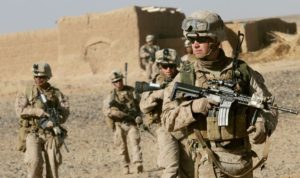It is bedlam in Kabul. After 20 years of the world’s strongest military apparatus being stationed in Afghanistan and rebuilding a war-torn land, the Taliban has retaken control of many parts of the Middle Eastern country. Now that the nation is back in the spotlight, it would be appropriate to conduct a cost accounting analysis of a situation whereby a soldier who was first deployed to Kandahar or Jalalabad in 2001 could see his son or daughter become eligible to serve in this war. The CliffNotes edition of the economics? Twenty years, $2 trillion, and a vast amount of fraud and waste of U.S. taxpayer dollars.
The Economics of Afghanistan
 According to the Costs of War project authored by Brown University’s Watson Institute and Boston University’s Pardee Center, the U.S. government has spent approximately $2.26 trillion on the war in Afghanistan. For combat operations in both Afghanistan and Pakistan, America spent at least $1 trillion. Lawmakers allocated $296 billion for veterans’ health care, but this does not include lifetime care and disability benefits for soldiers, which is estimated to balloon to $2.5 trillion. Another roughly $500 billion went to interest payments on war borrowing.
According to the Costs of War project authored by Brown University’s Watson Institute and Boston University’s Pardee Center, the U.S. government has spent approximately $2.26 trillion on the war in Afghanistan. For combat operations in both Afghanistan and Pakistan, America spent at least $1 trillion. Lawmakers allocated $296 billion for veterans’ health care, but this does not include lifetime care and disability benefits for soldiers, which is estimated to balloon to $2.5 trillion. Another roughly $500 billion went to interest payments on war borrowing.
On the nation-building front, the United States had earmarked $144 billion on reconstruction activities and $36 billion on governance. Moreover, Congress had budgeted roughly $50 billion a year for offensive operations and training (before the withdrawal), with the United States and NATO committing another $4 billion annually until 2024 to funding Afghanistan’s armed forces.
Overall, the initiative anticipates that U.S. interest payments on existing debt to fight the wars in Afghanistan and Iraq could top $8 trillion in the next 30 years. Boston University’s Heidi Peltier explained in a paper for the group:
“The expense of war is not restricted to the annual budgetary costs of the war spending itself, but also depends upon the way in which war is financed. When war is financed through debt, the costs are much greater than when it is financed through taxation or other revenues since interest payments must be made as long as the debt is outstanding. In fact, interest payments can sometimes grow to beyond the level of the debt itself, as will likely be the case with the post-9/11 wars.”
This does not include the human costs. Here is a tally of the lives lost in this battle:
- American service members: 2,448
- U.S. contractors: 3,846
- Allied military personnel: 1,144
- Aid workers: 444
- Journalists: 72
- Afghan military, police, and civilians: 110,000+
A Slap in the Face to Soldiers?
In March, the Special Inspector General for Afghanistan Reconstruction (SIGAR) produced another damning report on the billions of U.S. taxpayer dollars deployed to build, finance, and subsidize local infrastructures, such as hospitals, bridges, roads, and schools. The study noted that U.S. officials had been “pouring too much money, too quickly, into a country too small to absorb it,” building on previous examinations since it was founded in 2008.
 In its latest investigation, SIGAR assessed just $7.8 billion that had been assigned to reconstruction efforts in Afghanistan, including the Department of Defense’s $6.5 billion contribution. The watchdog concluded that only $1.2 billion were used as intended and just $343.2 million were “maintained in good condition.” A key component of the analysis had been that many of the facilities and assets were given to the local government without determining if they were wanted or needed or could be technically maintained.
In its latest investigation, SIGAR assessed just $7.8 billion that had been assigned to reconstruction efforts in Afghanistan, including the Department of Defense’s $6.5 billion contribution. The watchdog concluded that only $1.2 billion were used as intended and just $343.2 million were “maintained in good condition.” A key component of the analysis had been that many of the facilities and assets were given to the local government without determining if they were wanted or needed or could be technically maintained.
“The fact that so many capital assets wound up not used, deteriorated or abandoned should have been a major cause of concern for the agencies financing these projects,” John Sopko, the Special Inspector General, said about the findings.
Over the years, here are some of the most bizarre and egregious discoveries of squandering tax money:
- $500,000 on buildings that “melted” in the rain.
- $335 million for a power planet that consumed 1% of its capacity.
- $7.8 million on an empty industrial park.
- $36 million on a military facility that generals did not want.
- $7 million on communication towers that cannot be used.
- $46 million from stolen paychecks.
- $400 million on governance programs that did not meet goals.
Cut America’s Losses?
In the investment world, financial experts recommend investors to cut their losses early since the funds would be better utilized for another stock or exchange-traded fund. Should the United States have abandoned its rebuilding crusade following the death of Osama bin Laden? Should administrations have known better after former President Jimmy Carter’s Operation Cycle four decades ago? By all key performance indicators and objective analyses, it is clear that the war in Afghanistan had turned into a sunk cost for years. How many more generations of lives and dollars will be lost in this conflict?
~
Read more from Andrew Moran.




